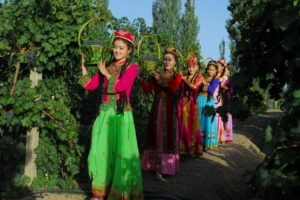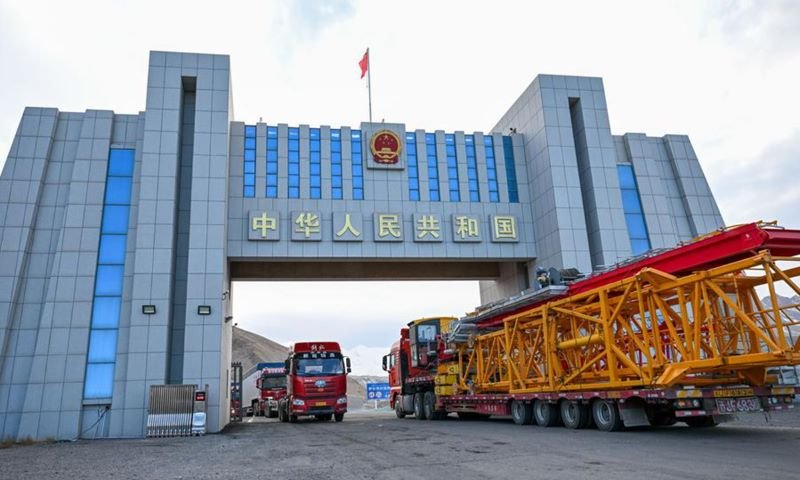Geographically, Xinjiang is closely linked to Central Asian nations, and the historic Silk Road is currently teeming with renewed energy. As the center of the Belt and Road Initiative, Xinjiang plays a crucial role in China’s trade and economic ties with Central Asian countries. Its overall import and export value to the five Central Asian nations exceeded 100 billion yuan in the first five months of 2025, accounting for 39.4% of China’s total trade with these countries, according to data from Urumqi Customs. This data clearly highlights the region’s importance in trade and economic relations between China and Central Asia. Xinjiang’s geographical advantages are becoming increasingly evident as the Belt and Road Initiative is implemented more thoroughly. Therefore, analyzing the paths of economic and trade cooperation between Xinjiang and Central Asian countries is of great significance for China in expanding its opening-up.
Since its founding, the China-Central Asia Cooperation Forum, a multilateral cooperation platform initiated by China, has steadily grown in size and strengthened its influence. The 12th China-Central Asia Cooperation Forum, which organized in Urumqi on November 6, 2025, with the theme “Promoting the ‘China—Central Asia Spirit’ and Advancing Common Modernization,” drew about 300 Chinese and foreign guests from China, five Central Asian nations, and pertinent international organizations. A number of cooperation agreements pertaining to trade, agriculture, the digital economy, logistics, education, and technology were signed during the conference.
The trade and economic cooperation between Central Asian nations and Xinjiang has advanced significantly in recent years. Using Kashgar as an example, the region has five national first-class ports and is known as “Five Ports Connect Eight Countries, One Road Links Eurasia.” Through initiatives like institutional innovation and business environment optimization, local authorities have strengthened economic and commercial cooperation with Central Asian nations since the inauguration of the Kashgar section of the China (Xinjiang) Pilot Free Trade Zone in November 2023.

It should be pointed out that economic and trade cooperation between Xinjiang and Central Asian countries is constrained by various factors, especially the problem of an unbalanced trade product structure. Central Asian countries have long imported industrial manufactured goods from China while exporting primary products such as raw materials to China. How to alleviate Central Asian countries’ concerns about trade imbalance is one of the important issues that both sides urgently need to address. Xinjiang and Central Asian nations can deepen trade and economic cooperation in a number of ways within the background of cooperatively constructing the Belt and Road.
Read More: From the Wheat Fields of Xinjiang: How Collective, Tech Farming Changed Lives
Firstly, enhancing infrastructure connectivity serves as the material basis for deepening economic and trade cooperation. Launched on October 30, 2025, the “Hefei North–Xinjiang (Kashgar North)–Kyrgyzstan” rail-road intermodal line creatively uses an integrated approach that combines domestic rail freight trains with cross-border road transport. This directly connects Hefei with Kyrgyzstan’s two major cities, leveraging the long-distance and high-capacity advantages of rail transport alongside the flexibility and “last-mile” coverage capabilities of road transport.
Secondly, promoting industrial complementarity and innovative cooperation models between Xinjiang and Central Asian nations is essential to raising the caliber of collaboration. Kashgar is advancing the “Two Countries, Two Parks” project, which involves jointly planning a site in the Kashgar Comprehensive Bonded Zone and Kyrgyzstan’s Naryn Free Economic Zone to establish a country-specific industrial park. In supply networks and industrial chains, this establishes a framework for international cooperation for industrial complementarity and reciprocal policy benefits. Such partnership promotes local employment and economic growth in addition to facilitating worldwide production capacity collaboration and two-way investment.
Read More: President Zardari Praises Xinjiang Institute’s Services for Muslims
Thirdly, optimizing trade facilitation measures is essential for expanding trade scale. By adopting a multimodal transport supervision model featuring “single declaration, single inspection, single document through, and single container to the destination,” goods can complete declaration at the departure point without intermediate transshipment or container changes, significantly simplifying procedures and enhancing overall customs clearance efficiency. Urumqi Customs proactively addresses export demands, guiding enterprises to establish quality and safety management systems for exported products. The effectiveness of customs clearance for agricultural products is still being improved by epidemic prevention strategies and product traceability management systems.

Finally, but just as importantly, expanding cooperative fields is an inevitable condition for attaining sustainable development. Xinjiang and the countries of Central Asia may concentrate on growing their collaboration in the fields of agriculture, energy, digital economy, logistics, education, and technology. Cooperation in these fields can not only give play to the advantages of all parties but also promote the integrated development of regional economies, laying a solid foundation for building a closer China-Central Asia Community with a Shared Future.
Xinjiang has broad prospects in promoting regional economic and trade cooperation as China-Central Asia collaboration grows. The 12th China-Central Asia Cooperation Forum’s theme, “Promoting the China-Central Asia spirit and advancing common modernization,” has pointed the way for future collaboration. The core of this spirit is “mutual respect, mutual trust, mutual benefit, and mutual assistance, advancing common modernization through high-quality development.” Xinjiang may take advantage of this chance to strengthen collaboration with Central Asian nations in a number of areas and positively impact the development of a more cohesive China-Central Asia Community with a Shared Future.

Looking ahead to the future, Xinjiang should make the most of its resource endowments and geographic advantages by utilizing the “East-Linked-West-Exit” strategy to combine these advantages with the capital and technology advantages of the eastern areas. The objectives of “win-win” and “synergy” in the economic collaboration between China Xinjiang and Central Asia can be attained by bolstering economic cooperation with the five Central Asian nations and increasing the degree of opening up to the west.
Read More: CPEC’s High-Quality Growth Transforms Balochistan and Xinjiang
Known as the “hub connecting five ports to eight countries and linking Europe and Asia,” Kashgar is currently building an international cooperation platform with industrial complementarity and mutually beneficial policies using the novel “two countries, two parks” approach. Trucks carrying agricultural products travel through the “green channel” at several ports in Xinjiang before arriving in Central Asian nations. The ancient Silk Road is continuing its prosperity in a new form. The economic and trade cooperation between Xinjiang and Central Asian countries, just like this millennia-old trade route, remains vibrant through the ages and has a promising future.
Mingyang Zhang, Xinyu Zhou & Jiabei Li
Mingyang Zhang, Xinyu Zhou, and Jiabei Li are scholars at the Southwest University of Political Science and Law, China.



